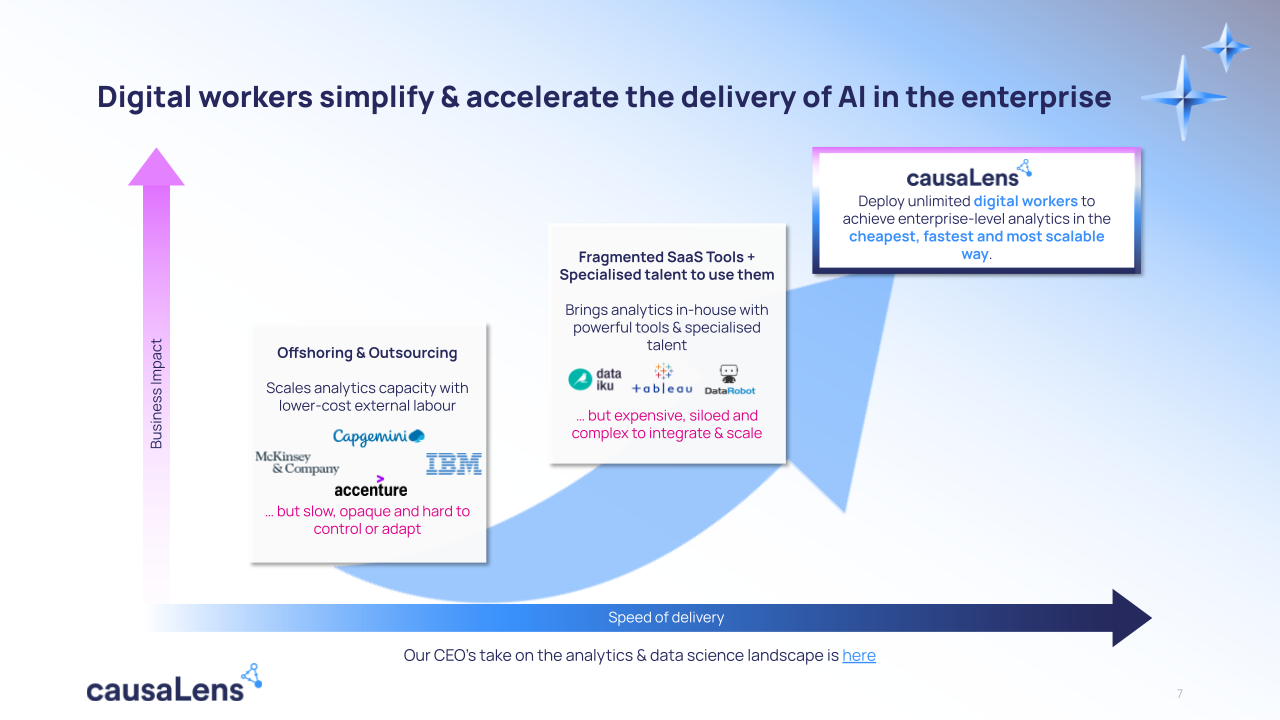The Future of Analytics & Data Science
The Future of Analytics & Data Science
The way enterprises handle analytics is undergoing a seismic shift. For years, companies have relied on two main approaches to scale their data capabilities:
- Offshoring & Outsourcing – Using external labor through companies like McKinsey, Capgemini, Accenture, and IBM to handle data workflows. While this approach provides capacity, it’s slow, opaque, and hard to control or adapt, leading to significant overhead and inefficiency.
- Fragmented SaaS Tools – Bringing analytics in-house with platforms like Dataiku, Tableau, and DataRobot, which rely on specialized talent. While these tools offer flexibility, they create silos, increase complexity, and require significant integration effort to deliver meaningful results.
But a new model is emerging. Digital workers simplify and accelerate the delivery of AI, removing the need for armies of consultants or fragmented toolkits. With digital workers, enterprises can deploy fully autonomous, production-grade systems that handle every part of the data lifecycle, from raw ingestion to actionable insights, delivering analytics faster, at lower cost, and at enterprise scale.
At causaLens, we enable businesses to deploy unlimited digital workers to achieve enterprise-level analytics in the cheapest, fastest, and most scalable way. This isn’t just a marginal improvement. It’s a fundamental shift in how data science is done.

The future of analytics and data science won’t be powered by better dashboards or more dashboards. It will be defined by a radical shift in how work gets done: through AI-native digital workers, not software tools.
The Stack is Flipping
The traditional analytics stack was built for humans:
- BI tools to explore data
- ETL tools to prepare it
- ML platforms to model it
- Analysts and consultants to stitch it all together
This human-centric stack is slow, fragmented, and expensive. The breakthrough we’re seeing now is not a better tool, but the emergence of AI agents that can own the entire analytics value chain.
These agents, built on platforms like causaLens, don’t just help, they do.
They ingest messy data, clean it, model it, explain it, and deliver outputs that are ready for production. They work inside enterprise environments, reason causally, and can be trusted with decisions, not just predictions.
The result? An analytics and data science function that operates autonomously, 24/7, with zero overhead and zero handoffs.
From Headcount to Agentcount
We’re at the beginning of a shift from headcount-based delivery to agentcount-based delivery.
Historically, scaling analytics meant hiring data scientists, analysts, ML engineers, DevOps, and visualization experts. This model hits a wall. There aren’t enough people, and the workflows are too fragmented.
Now, enterprises can deploy AI Data Scientists, digital agents that replace end-to-end workflows traditionally handled by humans or consultancies. For example, one causaLens unit can perform the work of 5–10 FTEs. And it scales horizontally with zero marginal cost.
In this world, the new question isn’t “how many analysts do we need?”
It’s: “What’s our agent footprint by function?”
From Service Providers to Service Replacers
The implications for the broader analytics ecosystem are massive. Consultancies, integrators, offshore delivery centers, and entire categories built on repeatable manual work will be replaced.
What we’re seeing now is the emergence of Services-as-Software. Rather than licensing software or hiring people, enterprises will purchase intelligent agents that deliver outcomes.
We’re already seeing this happen. Global companies, from infrastructure to pharma, are deploying agents in live business-critical workflows: forecasting demand, optimizing drug production, and analyzing investment scenarios.
They’re not asking for toolkits or pilots anymore. They’re asking: “Can we automate this entire function?”
To see how real enterprises are already using Autonomous AI Agents, from optimizing global supply chains to running automated pharmaceutical planning, watch the customer sessions from our cAI Conference.
The Role of the Human Analyst
This doesn’t spell the end of human analysts; it redefines their role.
Just as cloud computing elevated IT from maintenance to strategy, agentic AI will elevate data scientists from execution to orchestration.
Human experts will become managers of autonomous agent fleets, designing workflows, ensuring alignment with strategic goals, and intervening only when judgment is truly needed.
Analytics becomes a management function, not a production line.
This Future is Already Here
The future of analytics and data science isn’t theoretical; it’s happening now.
In just a few months, causaLens has deployed agents in some of the world’s largest enterprises, closed five enterprise deals in five weeks, and proved that digital labor for analytics isn’t hype, it’s ROI.
We’re no longer asking if this transformation is possible.
We’re asking how fast the world will catch up to it.
The Future of Data & Analytics is here.
We’re no longer asking if this transformation is possible. We’re asking how fast the world will catch up to it.